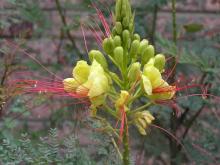
High Plains Gardening
The gardening website of the Texas High Plains Region

Desert never equates with drab. The flowers on Desert Bird of Paradise are simply stunning! Though classified as a Zone 7 plant, I’ve grown Desert Bird of Paradise for 3-4 years near a south facing wall and have seen several others around Amarillo, without it dying back it to roots. However, if it does, just prune out the dead wood. Eye catching flowers bloom continually from June into fall and attract hummingbirds. Finely divided green leaves. It is said to survive on 8” of rainfall, but monthly soakings enhance it. C. mexicana, Mexican Bird of Paradise and C. pulcherrima, Red Bird of Paradise, are not reliably cold hardy for our area, but are sometimes sold here. Reseeds some, but not enought to be a problem. Has a deep taproot. It may be native, but many sources list it as naturalized, originating in Argentina and Uruguay. Belongs to the cassia subdivision of the pea or legume, family, Fabaceae.
Hot and sunny area. Good accent plant at the back of a shrub border. Habitat and native plant garden.
Virtually none.